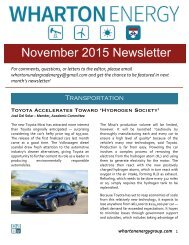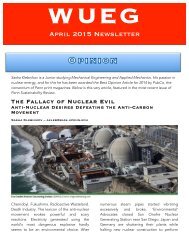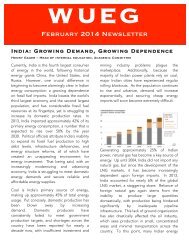Create successful ePaper yourself
Turn your PDF publications into a flip-book with our unique Google optimized e-Paper software.
<strong>September</strong> <strong>2015</strong> <br />
<strong>September</strong> <strong>2015</strong> <strong>Newsletter</strong><br />
Falling off the Cliff: Solar ITC Expiration<br />
Thomas Lee – Senior Member, Academic Committee<br />
The current US Congress consists mainly of <br />
partisan gridlock, having narrowly avoided a <br />
government shutdown on <strong>September</strong> 30 by <br />
approving a temporary budget bill just hours <br />
ahead of the deadline. Within this political context <br />
lies the future of the federal investment tax credit <br />
(ITC) for solar energy and American renewables <br />
infrastructure. <br />
Initiated by the 2005 Energy Policy Act, the solar <br />
ITC is a 30% tax credit on installation expenditures <br />
for solar energy projects. It was extended by the <br />
2008 Emergency Economic Stabilization Act to last <br />
until December 31, 2016, at which point the rate <br />
will drop to 10% for business solar investments <br />
(utility and commercial scale) and zero for <br />
residential systems. The 10% rate has no <br />
stipulated expiration. <br />
Historically, favorable tax policies, in the form of <br />
the ITC and MACRS depreciation, were <br />
instrumental in the explosive growth of solar <br />
generation capacity in the US. Based on EIA and <br />
FERC data, US solar PV and thermal generation <br />
capacity increased by a factor of 29 from 2005 (411 <br />
MW) to <strong>2015</strong> (12.36 GW). Last year alone, the solar <br />
industry created 31,000 new jobs; this represented <br />
22% growth versus overall US jobs growth of 1.1%. <br />
However, in the absence of the tax credits’ <br />
continuation, analysts project a substantial <br />
slowdown in solar build-‐out. For example, <br />
Bloomberg forecasts that the average annual solar <br />
installation capacity will decrease from 8 GW per <br />
year (over 2014 to 2016) to 6 GW per year (over <br />
2017 to 2022). In particular, a sharp "cliff" occurs <br />
right after expiration: BNEF projects 11.3 GW to be <br />
installed in 2016 versus 3.4 GW in 2017. This cliff <br />
would occur due to both the reduced tax benefits <br />
as well as solar developers rushing to complete <br />
projects before the deadline. While forecasted <br />
installation of utility, commercial, and residential <br />
scale projects all suffer under the expiration, BNEF <br />
projects that utility scale projects would be most <br />
severely affected. <br />
As expected, different interest groups have large <br />
stakes in whether these credits continue. For <br />
example, the Solar Energy Industries Association <br />
(SEIA) is lobbying rigorously to extend the credits. <br />
Perhaps counter-‐intuitively Camilo Patrignani, <br />
whartonenergygroup.com 1
<strong>September</strong> <strong>2015</strong> <br />
CEO of Greenwood Energy (an American solar <br />
company), supports eliminating the ITC in a <br />
Greentech Media op-‐ed, favoring more long term <br />
regulatory certainty. A paper from Stanford's <br />
Steyer-‐Taylor Center for Energy Policy and <br />
Finance advocates a similar middle path approach. <br />
Rather than the current policy of suddenly slashing <br />
the ITC rate to 10% in 2017 and maintaining it <br />
forever, the paper proposes a tapered extension (a <br />
smoother "glide path") to avoid the solar cliff, with <br />
the political tradeoff of ultimately eliminating the <br />
ITC entirely by 2022. <br />
While the US Congress is now suffering chronic <br />
disagreement and impasse, the 2016 presidential <br />
election discourse is similarly partisan on the topic <br />
of renewable energy tax credits. Almost all major <br />
Republican candidates who have spoken publicly <br />
on this issue support removing all energy subsidies <br />
(maintaining logical consistency by also <br />
advocating removal of all fossil fuel tax benefits), <br />
while almost all Democratic candidates support <br />
extending both solar investment tax credits and <br />
wind production tax credits (PTC). The future of <br />
the solar ITC is highly uncertain. With rapidly-transitioning<br />
energy infrastructure in an America <br />
flooded with cheap natural gas, this stalemated <br />
political atmosphere on the solar ITC might have <br />
lasting implications for the planet's atmosphere. <br />
Sources: <br />
AP <br />
DOE <br />
EIA <br />
FERC <br />
Utility Dive <br />
Stanford GSB <br />
BNEF <br />
League of Conservation Voters<br />
The Powerwall and the Future of Energy Storage<br />
at Tesla<br />
Connor Lippincott – Senior Member, Academic Committee <br />
Tesla’s announcement of the home energy-storage<br />
solution, the Powerwall, earlier this <br />
summer made some pretty big waves in the clean <br />
technology sphere. The sleek, wall-‐mounted <br />
battery comes in two models, 10 kWh and 7 kWh, <br />
for backup and daily cycle applications, <br />
respectively. The battery functions with traditional <br />
lithium-‐ion technology and is guaranteed for 10 <br />
years after purchase. The prices are $3000-‐$3500 <br />
with an additional $500 in installation charges. <br />
Since their announcement, 100,000 Powerwalls <br />
were reserved. Elon Musk, CEO of Tesla and Penn <br />
alumnus, has projected $40 million in sales of <br />
batteries for fourth quarter <strong>2015</strong> with “ten times <br />
that number next year.” And just a few days ago, <br />
the 7kWh batteries began shipping to customers. <br />
So this is a home run, right? <br />
It seems a little more complicated than that. While <br />
the Apple-‐esque rollout of the Powerwall dazzled <br />
many, there are some significant questions to the <br />
long-‐term use and effectiveness of the home <br />
storage battery. The primary selling points of the <br />
battery are grid independence and avoiding peak <br />
electricity rates. However, compared to net <br />
metering, the process of selling unused solar <br />
energy back to the grid, the battery storage is a <br />
more expensive option. Instead of making money <br />
from the excess energy, it is simply stored. <br />
Unfortunately, this policy is also one of the reasons <br />
that solar energy is becoming much more <br />
economical, meaning that, to incentivize battery <br />
purchase, solar panels would have to be dis-incentivized.<br />
This seems counterintuitive. <br />
Avoiding peak electricity rates also does not make <br />
as much impact when investigated. First, less than <br />
whartonenergygroup.com 2
<strong>September</strong> <strong>2015</strong> <br />
1% of U.S. Households are charged by time-‐of-‐use. <br />
Even among the 1% that are, differences in rates <br />
are not large enough to justify battery usage. It <br />
does seem, however, that time-‐of-‐use charging is <br />
increasing, so we may see this problem decrease in <br />
regards to the Powerwall. <br />
homeowners will buy this because it is the “next <br />
big thing”, and there is nothing wrong with that. <br />
Additionally, a larger scale version of the <br />
Powerwall for commercial purposes, rolling out in <br />
2016, will be much more effective as an energy <br />
solution. Reservations for those are over $600 <br />
million, though it seems the reservations are non-binding.<br />
<br />
While the Powerwall may not be right for the <br />
majority of American consumers, it will probably <br />
still be a good move for Tesla. First, the <br />
introduction, presentation, and marketing of the <br />
technology has been well done. Tesla is making <br />
high technology energy solutions seem, for lack of <br />
a better word, cool. A significant amount of <br />
It will be interesting to see how all of this plays out <br />
in the coming years. A new study at Harvard has <br />
already found an improved energy-‐storage fluid <br />
compared to the one used in the Powerwall, and <br />
many more technological innovations are surely on <br />
the brink of economic feasibility. While Tesla’s <br />
primary focus will continue to be on its cars, the <br />
increased interest in storage will encourage only <br />
the best solutions. <br />
Sources: <br />
Tesla Motors <br />
Bloomberg <br />
Wharton Energy Group Leads Successful Visit to<br />
Marcellus Shale Drilling Site<br />
Jack Tyree – President, <strong>WUEG</strong> <br />
On Friday, April 10th, members of the Wharton <br />
Undergraduate Energy Group travelled to <br />
Waynesburg, PA on a full-‐day field trip to a series <br />
of natural gas drilling and production sites in the <br />
Marcellus Shale. Facilitated by Vantage Energy, a <br />
Denver-‐based exploration and production <br />
company, the trip consisted of visits to three of <br />
natural gas production locations—one drilling <br />
operation, one flow-‐back operation, and one <br />
completed producing pad. <br />
The group’s first stop was the “Habe” pad, which is <br />
currently in the drilling phase of production. <br />
Sporting required fires-‐resistant clothing and hard <br />
hats provided by Vantage, the students had the <br />
opportunity to tour the drilling rig and learn about <br />
operations from on-‐site employees and <br />
consultants. <br />
One student reflected on the “Measurement While <br />
Drilling” technologies, which use gamma ray <br />
transducers to facilitate point-‐to-‐point precision in <br />
guiding the drill bit into the hydrocarbon reservoir <br />
at depths well in excess of a mile below the <br />
surface. Another student inquired about the <br />
company’s water acquisition and flow-‐back water <br />
disposal policy. The state of Pennsylvania <br />
approves certain points from which production <br />
companies can acquire fresh water for completion <br />
operations. To date, Vantage completion water <br />
whartonenergygroup.com 3
<strong>September</strong> <strong>2015</strong> <br />
has been obtained from the Monongahela River in <br />
Pennsylvania. Following completions, Vantage <br />
recycles the majority of recovered brine water for <br />
other operations. <br />
The group also visited Vantage’s “Good” pad, <br />
which was undergoing flow-‐back operations. By <br />
employing on-‐site pressure and temperature <br />
control, the machinery separates the flow-‐back <br />
contents, which generally include gas, oil, water, <br />
and sand. On location, Vantage’s EH&S Director <br />
fielded questions regarding land acquisition and <br />
property rights. “Oil and gas rights are actually <br />
very convoluted in Pennsylvania. Some <br />
landowners own all of the mineral rights and can <br />
lease those to oil and gas companies. Others sold <br />
off some or all of those mineral rights at some <br />
point in the past.” The latter is often the case with <br />
game lands used for hunting or occupied by <br />
animals. He went on to say, “In some cases, <br />
owners left their property to relatives a long time <br />
ago, so companies need to seek out approval for <br />
the mineral rights lease from dozens of people. <br />
This can really complicate things.” <br />
The group’s final stop was the “Petraitus” pad, <br />
which includes a series of completed wells <br />
currently linked to a gas transportation pipeline. <br />
One of the employees on location described the <br />
gas gathering system that connects all of the <br />
company’s wells. In order to prevent gas and <br />
methane leaks in the well piping, Pennsylvania <br />
requires that gas producers certify their steel <br />
piping on an annual basis. In addition, all joints in <br />
temporary piping must be outfitted with Kevlar <br />
bands, which serve as a secondary restraint to <br />
prevent leakage. <br />
The trip concluded with a dinner during which <br />
students had more opportunities to interact with <br />
the oil and gas drilling and production staff. The <br />
field trip was a great success, and students valued <br />
the opportunity to see first-‐hand the processes <br />
associated with natural gas production, a growth <br />
sector of Pennsylvania’s economy. <br />
To build on the rig visit experience and as part of <br />
our mission to promote exploration of the energy <br />
industry through experiential learning, on Friday, <br />
October 16th, <strong>WUEG</strong> will be conducting a site visit <br />
to the Bruce A. Henry solar farm in Delaware. The <br />
field trip will be open to all students interested in <br />
attending. For more information, please visit <br />
whartonenergygroup.com. <br />
Bill Gates’ TerraPower: The Future of Nuclear<br />
Energy?<br />
Charlie Gallagher – Vice President, Academic Committee<br />
Bill Gates doesn’t just pioneer computer operating <br />
systems; his renewable energy company <br />
TerraPower, founded in 2008, recently partnered <br />
with China to build a ground-‐breaking, next-‐<br />
generation nuclear reactor – one that is powered <br />
by depleted uranium. <br />
China’s National Nuclear Corporation (CNNC) <br />
agreed on <strong>September</strong> 22nd to build the first <br />
reactor in China’s Fujian province beginning in <br />
whartonenergygroup.com 4
<strong>September</strong> <strong>2015</strong> <br />
2017. This first plant, a 600 mega-‐watt prototype, <br />
will test all the necessary componentry and fuel as <br />
well as provide an economic and licensing basis for <br />
commercial viability in the years afterward. The <br />
plan is for 1,150 mega-‐watt commercial plants to <br />
follow, with operation beginning in the late 2020’s. <br />
The technology, Traveling Wave Reactor (TWR), <br />
relies on the conservation of energy. While existing <br />
nuclear reactors use only 5% of their uranium ‘fuel’ <br />
and then dispose it, TWRs use a bit of enriched <br />
uranium to start up then utilize so called depleted <br />
uranium – the toxic waste from today’s nuclear <br />
reactors – as its primary fuel source. The plants can <br />
load up nearly 40 years’ worth of fuel in one fell <br />
swoop, whereas traditional nuclear plants must <br />
conduct the expensive and gritty refueling process <br />
every 18 to 24 months. <br />
The economic and environmental benefits of <br />
nuclear energy are apparent: it is clean, carbon-free<br />
power that provides base load capacity (24/7 <br />
electricity) at a fraction of the cost of wind and <br />
solar. But the TWR technology in particular is <br />
promising because it reduces the need for uranium <br />
mining, enrichment facilities, reprocessing plants <br />
and storage facilities. Instead of burying depleted <br />
(and radioactive) nuclear fuel rods in the ground, <br />
these nuclear reactors recycle that very uranium. <br />
Beyond the cost savings, this method mitigates <br />
the proliferation of nuclear weapons <br />
manufacturing. Since the plant can undergo fission <br />
from this recycled fuel source for decades, the <br />
resulting uranium waste is unusable for weapons <br />
manufacturing and contains lower levels of <br />
radioactivity. In other words, the depleted uranium <br />
these plants will purchase for fuel might otherwise <br />
have been obtained for nuclear weapons. <br />
For those interested in the science and <br />
engineering, TerraPower’s website goes into <br />
further detail: <br />
The TWR is a Generation IV, liquid sodium-‐cooled <br />
fast reactor based on existing fast reactor <br />
technologies. Innovations in metallic fuel, cladding <br />
materials and engineering allow TWRs to utilize <br />
depleted uranium as their primary fuel. Fissile fuel is <br />
both produced and then consumed in-‐reactor, <br />
greatly improving the fuel efficiency of the TWR and <br />
resource availability for the reactor. The TWR’s <br />
economic benefits stem from its higher thermal <br />
efficiency and ability to breed and burn metallic fuel <br />
comprised of initial starter fuel of U-‐235 and U-‐238. <br />
TerraPower’s ability to develop new fuels and <br />
materials that can breed and burn U-‐238 could <br />
enable a TWR to get more energy out of every pound <br />
of mined uranium than a conventional light water <br />
reactor. <br />
A new generation of nuclear plants can make for a <br />
cheaper and safer future for the industry. <br />
Sources: <br />
TerraPower <br />
KPLU <br />
whartonenergygroup.com 5
<strong>September</strong> <strong>2015</strong> <br />
Alternative Energy Yield Companies: Gimmick or<br />
Game Changer? <br />
Max Isenberg – Senior Member, Academic Committee<br />
One of the core problems for a capital intensive <br />
and growing industry is financing. In the past 2 <br />
years, alternative energy companies have <br />
gravitated towards yield companies (or yieldcos) as <br />
the solution. The first alternative energy yield <br />
company was Brookfield Renewable Energy <br />
Partners, which IPO’d in 2012. By mid <strong>2015</strong>, the <br />
number of yieldcos had risen above 15, raising over <br />
$12 billion in capital for their parent companies. <br />
What has been encouraging so many firms to <br />
pursue this new source of capital, and will they <br />
remain the method of choice for the foreseeable <br />
future? <br />
To an investor, a yieldco offers up a similar value <br />
proposition as a real estate trust fund (REIT) or a <br />
master limited partnership (MLP). All three <br />
investment vehicles essentially collect the cash <br />
flows of very stable and highly capital-‐intensive <br />
assets (either solar modules/wind turbines, large <br />
real estate portfolios, or oil pipelines) and pay cash <br />
flows out in the form of dividends to investors, <br />
with the operations of acquiring and constructing <br />
the assets being left to the parent company. For <br />
the parent companies, the motivations also are <br />
quite similar among all of these types of <br />
subsidiaries. To get the financing for very <br />
expensive projects (be it building solar farms, <br />
buying up lots of property, or laying down an oil <br />
pipeline), existing assets can be “dropped down” <br />
into a subsidiary and subsequently IPO’d to raise <br />
capital off of their existing assets. Yieldcos also <br />
benefit tremendously from tax breaks, as parent <br />
companies can earn significant tax-‐offsetting net <br />
operating losses (NOLs) via non-‐cash depreciation <br />
expenses associated with these assets. Thus, firms <br />
can raise capital, pay low-‐risk dividends, and avoid <br />
taxes. <br />
Up until the summer of <strong>2015</strong>, investors <br />
aggressively sought Yieldcos for investment. In a <br />
low interest rate environment, attaining higher <br />
yields is very difficult, and so yieldcos, which pay <br />
the equivalent of 4.5 -‐ 7.5% annually, are highly <br />
sought after. Energy companies, and in particular <br />
photovoltaics manufacturers like First Solar and <br />
SunEdison, have continued to bundle their assets <br />
for new yieldcos. To these module makers, the <br />
yieldco has enabled them to raise relatively cheap <br />
capital in large quantities with relative ease. <br />
However, after SunEdison’s most recent yieldco <br />
IPO, Terraform Global, the music may have <br />
stopped for the yieldco party. Unlike the other <br />
yield companies that experienced large pops in <br />
their stock price post IPO, Terraform Global <br />
declined 6% on its first day and never returned to <br />
its IPO price. Existing yieldcos have also faced <br />
significant losses. Several theories abound as to <br />
why the good fortune for yield companies has so <br />
suddenly reversed. The Federal Reserve is <br />
expected to begin raising interest rates soon, <br />
making the dividends that yieldcos pay seem less <br />
whartonenergygroup.com 6
<strong>September</strong> <strong>2015</strong> <br />
attractive in the face of rising bond yields. The <br />
rapid series of IPOs may have flooded the market <br />
with these types of securities, oversaturating <br />
demand and reducing investors’ willingness to pay <br />
the high prices that yieldcos were commanding <br />
just a few months previously. <br />
There is hope still for solar companies even if the <br />
yieldcos decline in prominence. The Moody’s <br />
Rating Agency stated in January that solar asset-backed<br />
securities (with which SolarCity has <br />
experimented) had reached enough scale to come <br />
to market. Rather than bundling alternative energy <br />
assets into new companies, these assets could be <br />
used to back bonds that parent companies issue. <br />
As a backed security, these “solar bonds” would be <br />
less risky to investors and could potentially be <br />
issued more cheaply than by IPO’ing new <br />
subsidiaries. AES Distributed Energy launched the <br />
first solar bond issued by a utility in <strong>September</strong> <br />
<strong>2015</strong>, supporting the viability of this security as a <br />
critical way alternative energy gets funded in the <br />
future. It is up to capital markets to decide whether <br />
yieldcos are a gimmick or a game changer. <br />
Sources: <br />
NREL<br />
Cleantechnica<br />
Green Tech Media<br />
Bloomberg<br />
Ukraine’s Energy Crisis: Is Nuclear an Option?<br />
Arnab Sarker – Guest Columnist<br />
Ukraine is currently facing an unprecedented <br />
energy crisis. After rebels declared independence <br />
from Kiev a year ago, military conflict took place <br />
over the Donbass region of Ukraine. Over 300 <br />
mines were ruined in the now war-‐torn area. <br />
According to the Ukraine Ministry of Energy, the <br />
overall production of raw coal in Ukraine fell by <br />
over 20%. However, a significant part of Ukraine’s <br />
energy presently comes from natural gas, so a fall <br />
in coal production itself would not entail a crisis. <br />
Unfortunately, Ukraine’s energy problems are <br />
exacerbated by political tensions with Russia. <br />
Russia is one of the world’s biggest suppliers of <br />
natural gas, and it provides its gas to Eastern <br />
Europe by transporting its gas through pipes that <br />
run through Ukraine. As a result, Ukraine has <br />
become dependent on Russia for imported natural <br />
gas. Yet the Russian annexation of Crimea, a region <br />
south of Ukraine, has given Ukraine the incentive to <br />
seek energy independence from Russia. <br />
Since coal is no longer an option, Ukraine’s energy <br />
independence may be viable if it makes use of <br />
nuclear energy, but Ukraine has had terrible press <br />
regarding nuclear energy, especially because of the <br />
Chernobyl accident. After Unit 4 of Chernobyl’s <br />
reactor failed in 1986, parts of Ukraine, Belarus, and <br />
Russia were left contaminated, and the world was <br />
left in fear of nuclear power. This led to the halt of <br />
nuclear power plant growth in Ukraine. Eventually, <br />
policy began to change, since nuclear energy <br />
actually has one of the lowest death rates per <br />
kilowatt-‐hour generated. Now there are fifteen <br />
nuclear plants in Ukraine, and this number may <br />
whartonenergygroup.com 7
<strong>September</strong> <strong>2015</strong> <br />
increase as Ukraine hopes to become less <br />
dependent on Russian natural gas. Nearly thirty <br />
years after Chernobyl, a nuclear renaissance may be <br />
Ukraine’s best solution. <br />
Sources <br />
Bulletin of the Atomic Scientists <br />
Euractiv <br />
Event review: Impacts of Fracking<br />
A technical presentation and discussion on policy<br />
Zach Ennis – Vice President, Events Committee<br />
On <strong>September</strong> 22, the Wharton Undergraduate <br />
Energy Group and Penn Sustainability Review <br />
hosted a presentation and discussion panel on the <br />
topic of hydraulic fracturing, more commonly <br />
known as fracking, in North America. <br />
The event began with an approximately 20 minute <br />
video presentation on exploration, drilling, and <br />
completion. Prior to beginning the presentation, <br />
the audience was cautioned that the video series <br />
was prepared by Chesapeake Energy, one of the <br />
largest natural gas producers in the United States, <br />
and as such could demonstrate the topic in a <br />
biased manner. Overall, the presentation was <br />
objective and mostly technical in nature. After the <br />
video, students asked more critical questions <br />
regarding possible environmental damages to add <br />
an opposing opinion. <br />
A panel followed with a more neutral discussion of <br />
the impacts of fracking that was moderated by <br />
second-‐year MBA, Pujan Kasaju. Pujan has <br />
extensive experience in the oil and gas financial <br />
sphere – specifically his previous employment was <br />
at the energy private equity giant, Riverstone <br />
Holdings. <br />
The three panelists included: Professor Andrew <br />
Jackson, Dillon Weber, and Sasha Klebnikov. <br />
Professor Jackson previously worked for over two <br />
decades in various fluid sciences with Exxon Mobil <br />
and is now a professor of tribology in the Penn <br />
Engineering School. Dillon is a senior majoring in <br />
Chemical Engineering and Economics. He has <br />
researched gas production and written extensively <br />
on the associated tax policies, especially in the <br />
Marcellus Shale. Lastly, Sasha is pursuing his <br />
Masters in Heat Transfer and Energy Science and <br />
serves as the Editor in Chief of the Penn <br />
Sustainability Review. <br />
The panel started off with questions on the <br />
environmental impacts of fracking, a hot topic in <br />
the media and politics. Professor Jackson prefaced <br />
the discussion by suggesting that students keep in <br />
mind the potential detriments associated with all <br />
energy sources. Panelists then continued to <br />
discuss the impacts of various energy sources and <br />
how fracking compares. The general sentiment <br />
was positive with the rationale that fracking has <br />
the ability to replace coal as a cheaper, less <br />
detrimental power source. Panelists also discussed <br />
and cited statistics about the misconceptions of <br />
methane leakages, possibility for groundwater <br />
contamination, and wastewater disposal. All three <br />
agreed that fracking was definitely a hazard 10 to <br />
15 years ago when regulation was minimal and the <br />
industry was so new, but now the industry has <br />
evolved to improve their techniques to be <br />
whartonenergygroup.com 8
<strong>September</strong> <strong>2015</strong> <br />
relatively safe. In addition, companies now face <br />
steep fines for spills or other human errors. <br />
The conversation expanded to analyze the current <br />
presidential campaign and the candidates’ <br />
positions on fracking. This led to a discussion of <br />
the taxes on oil and gas production companies, as <br />
well as the local economic effects caused by the <br />
shale revolution in the United States. <br />
One of the final topics analyzed the potential <br />
impact of the current low oil prices on oil and <br />
energy extraction techniques. Some opinions <br />
included the potential development for longer <br />
laterals, more intense fracks, and an increase in <br />
wells per pad. <br />
We held a 20 minute question and answer session, <br />
where the audience asked engaging questions <br />
clearly highlighting the educational value and <br />
benefit from the event. All in all, it was great to see <br />
everyone leave with a greater understanding of the <br />
technical aspects, regulatory measures, and <br />
economics behind fracking. <br />
whartonenergygroup.com 9









